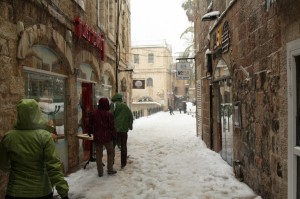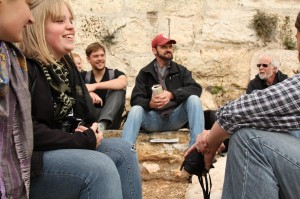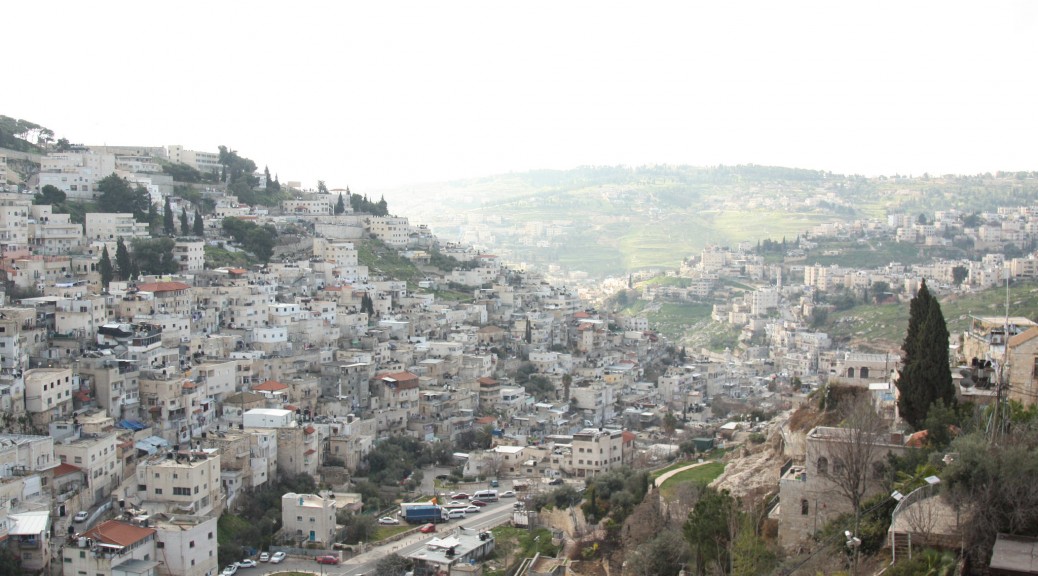 We arrived back from free travel and dove right back into the Old City of Jerusalem. We spent the week in a convent called Ecce Homo, which translates to “behold the man”. The arch that goes over the street adjacent to the convent has been suggested as the site where Pilate presented Jesus. The whole week has been focused on the Old City and how Judaism fits in there. We had lectures on Jewish history as well as 10 hours of Hebrew language.
We arrived back from free travel and dove right back into the Old City of Jerusalem. We spent the week in a convent called Ecce Homo, which translates to “behold the man”. The arch that goes over the street adjacent to the convent has been suggested as the site where Pilate presented Jesus. The whole week has been focused on the Old City and how Judaism fits in there. We had lectures on Jewish history as well as 10 hours of Hebrew language.
Learning Hebrew proved to be quite the task, as our instructor informed us that she normally takes 50 hours to teach the letters completely. We only had 10 hours to learn the letters and some basic phrases. The pace of the class did not stop us from giving our best effort to learn. We ended up being able to sing some songs to help us remember how to say “good morning, evening and goodnight” and some traditional shabbat songs.
On Tuesday afternoon, we had the opportunity go investigate Yad Vashem, one of the official holocaust museums of Israel. Its name literally translates into hand and name. The hand (yad) has been used to refer to many monuments in the country. And name (shem) is used to remember all of the names of those who were killed in the Holocaust.
It was a very intense day to say the least. For me, it brought feelings of frustration with humanity, sadness, sympathy, and hope for something better. It was different to experience a Holocaust museum here than in Washington DC. The narrative was completely different. While it doesn’t justify a lot of the violence and injustice that we have seen or felt, it certainly brought an understanding to me at least for the aggressively-defensive position Israel appears to impress on the world stage.
Our last full day in Jerusalem was an independent study of the places where Jesus was on his last day before he was crucified. We visited the Upper Room, Peter in Gallicantu, the Garden of Gethsemane, the Garden Tomb, and the Via Dolorosa. Personally speaking, I felt like it was difficult to get into a reflective mentality due to the massive number of pilgrims that were visiting the sites. I appreciated the opportunity to go and visit them on our own rather than EMU going as one large group. I think that it took on a different feel to do it individually. As Americans, I believe that we approach the Bible and expand and fantasize the stories that we read. The city is so compact, the whole walk took only a few hours in the morning. The story follows a logical path from the wealthy district up on Mount Zion, where the last supper has historically been thought to have taken place, down the valley to the Garden of Gethsemane. Along the way is Peter in Gallicantu, where Peter denied Jesus three times. While many of the sites note that there is no concrete proof that the event happened at that exact place, the significance remains the same. For it is not what is, but that other people believe other people believe what it is, that matters. I imagined what the disciples must have felt that night. Down in the garden, the story says they fell asleep when Jesus went off to pray. Luke 22:45 “When he rose from prayer and went back to the disciples, he found them asleep, exhausted from sorrow.” If they were exhausted from sorrow at this point in the night, what must they have felt when they saw their Lord, their Teacher, up on the cross being crucified? It brought about a whole new collection of thoughts for me as I processed the death of Jesus from this place.
This week has been a nice disconnect from the Palestine-Israel conflict as far as the studies go, but the tension is always in the air. Our group continues to press on and dig into the hard questions. The continued support for the trip is appreciated as we find ourselves frustrated and confused at times. We also thank you for celebrating in the joys we see all around this beautiful country in the pictures we take.
-Derek Harnish, 3rd year
3/15/15
Warning – this post contains intensely nostalgic writing.
How can we leave this place just as it was starting to feel like home? People always say that you never have the right amount of time in a place – it’s either too much or too little – but I could’ve spent another two weeks exploring the beautiful streets of Old City Jerusalem. Why will I miss it so much? For a whole week, the Temple Mount was my front yard. The Western Wall was within walking distance. The best falafel in town, a five minute walk down the street. Every day I crossed paths with hundreds of pilgrims, Muslims, Jews, and tourists. In fact, it’s the people that I might miss the most.
 The city is vibrant in ways that transcend postcards or pictures, because it is composed of real people living real lives. Visiting holy sites is significant and important, but you have to pay the price of commercialization. You have to wait for hours in lines and navigate huge masses of people to touch the stone where they think maybe Jesus’ tomb might have been. You pay entrance fees and try to get a picture of the church without a dozen strangers being in the frame. Forget trying to focus or meditate in any of the sites, because all of the tour guides will be fighting to be heard in the pandemonium. No, give me the quiet side streets that no one knows about. Let me wander through markets and squares with no agenda or destination. Allow me to explore, and I will gain insight into more than that which affirms my traditions.
The city is vibrant in ways that transcend postcards or pictures, because it is composed of real people living real lives. Visiting holy sites is significant and important, but you have to pay the price of commercialization. You have to wait for hours in lines and navigate huge masses of people to touch the stone where they think maybe Jesus’ tomb might have been. You pay entrance fees and try to get a picture of the church without a dozen strangers being in the frame. Forget trying to focus or meditate in any of the sites, because all of the tour guides will be fighting to be heard in the pandemonium. No, give me the quiet side streets that no one knows about. Let me wander through markets and squares with no agenda or destination. Allow me to explore, and I will gain insight into more than that which affirms my traditions.
Given the chance, I just might come away loving the people more than the place. I will always treasure the opportunity to read the Bible in the land where it all happened, but it’s the people who make it all real. They are the lifeblood of this vibrant city and the witness – silent and not-so-silent – to everything that has ever happened. The story of Jerusalem truly lies with the people, and I am forever grateful for just the slightest glimpse into the encyclopedia that is the Old City.
-Lauren Sauder, Junior

